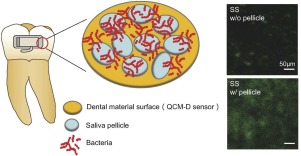当前位置:
X-MOL 学术
›
Colloids Surf. B Biointerfaces
›
论文详情
Our official English website, www.x-mol.net, welcomes your feedback! (Note: you will need to create a separate account there.)
Physical-chemical interactions between dental materials surface, salivary pellicle and Streptococcus gordonii.
Colloids and Surfaces B: Biointerfaces ( IF 5.8 ) Pub Date : 2020-03-03 , DOI: 10.1016/j.colsurfb.2020.110938 Ting Sang 1 , Zhou Ye 2 , Nicholas G Fischer 2 , Erik P Skoe 2 , Constanza Echeverría 3 , Jun Wu 4 , Conrado Aparicio 2
Colloids and Surfaces B: Biointerfaces ( IF 5.8 ) Pub Date : 2020-03-03 , DOI: 10.1016/j.colsurfb.2020.110938 Ting Sang 1 , Zhou Ye 2 , Nicholas G Fischer 2 , Erik P Skoe 2 , Constanza Echeverría 3 , Jun Wu 4 , Conrado Aparicio 2
Affiliation

|
Dental materials are susceptible to dental plaque formation, which increases the risk of biofilm-associated oral diseases. Physical-chemical properties of dental material surfaces can affect salivary pellicle formation and bacteria attachment, but relationships between these properties have been understudied. We aimed to assess the effects of surface properties and adsorbed salivary pellicle on Streptococcus gordonii adhesion to traditional dental materials. Adsorption of salivary pellicle from one donor on gold, stainless steel, alumina and zirconia was monitored with a quartz crystal microbalance with dissipation monitoring (QCM-D). Surfaces were characterized by X-ray photoelectron spectroscopy, atomic force microscopy and water contact angles measurement before and after pellicle adsorption. Visualization and quantification of Live/Dead stained bacteria and scanning electron microscopy were used to study S. gordonii attachment to materials with and without pellicle. The work of adhesion between surfaces and bacteria was also determined. Adsorption kinetics and the final thickness of pellicle formed on the four materials were similar. Pellicle deposition on all materials increased surface hydrophilicity, surface energy and work of adhesion with bacteria. Surfaces with pellicle had significantly more attached bacteria than surfaces without pellicle, but the physical-chemical properties of the dental material did not significantly alter bacteria attachment. Our findings suggested that the critical factor increasing S. gordonii attachment was the salivary pellicle formed on dental materials. This is attributed to increased work of adhesion between bacteria and substrates with pellicle. New dental materials should be designed for controlling bacteria attachment by tuning thickness, composition and structure of the adsorbed salivary pellicle.
中文翻译:

牙科材料表面,唾液薄膜和戈登链球菌之间的物理化学相互作用。
牙科材料易于形成牙菌斑,从而增加了生物膜相关口腔疾病的风险。牙科材料表面的物理化学性质会影响唾液薄膜的形成和细菌附着,但这些性质之间的关系尚未得到充分研究。我们旨在评估表面特性和唾液薄膜防护膜对戈登链球菌对传统牙科材料的附着力的影响。用具有耗散监测功能的石英晶体微量天平监测来自一个供体的唾液薄膜在金,不锈钢,氧化铝和氧化锆上的吸附。通过X射线光电子能谱,原子力显微镜和膜吸附前后的水接触角来表征表面。活/死染色细菌的可视化和定量以及扫描电子显微镜用于研究戈氏链球菌附着于有或没有防护膜的材料上的情况。还确定了表面与细菌之间的粘附功。四种材料上形成的薄膜的吸附动力学和最终厚度均相似。球囊在所有材料上的沉积均增加了表面亲水性,表面能以及与细菌的粘附作用。带有防护膜的表面与没有防护膜的表面相比,附着细菌明显更多,但是牙科材料的物理化学性质并未明显改变细菌的附着。我们的发现表明,增加戈登氏链球菌附着的关键因素是在牙科材料上形成的唾液薄膜。这归因于细菌与防护膜之间的粘附力增加。应设计新的牙科材料,以通过调节所吸收唾液薄膜的厚度,成分和结构来控制细菌附着。
更新日期:2020-03-03
中文翻译:

牙科材料表面,唾液薄膜和戈登链球菌之间的物理化学相互作用。
牙科材料易于形成牙菌斑,从而增加了生物膜相关口腔疾病的风险。牙科材料表面的物理化学性质会影响唾液薄膜的形成和细菌附着,但这些性质之间的关系尚未得到充分研究。我们旨在评估表面特性和唾液薄膜防护膜对戈登链球菌对传统牙科材料的附着力的影响。用具有耗散监测功能的石英晶体微量天平监测来自一个供体的唾液薄膜在金,不锈钢,氧化铝和氧化锆上的吸附。通过X射线光电子能谱,原子力显微镜和膜吸附前后的水接触角来表征表面。活/死染色细菌的可视化和定量以及扫描电子显微镜用于研究戈氏链球菌附着于有或没有防护膜的材料上的情况。还确定了表面与细菌之间的粘附功。四种材料上形成的薄膜的吸附动力学和最终厚度均相似。球囊在所有材料上的沉积均增加了表面亲水性,表面能以及与细菌的粘附作用。带有防护膜的表面与没有防护膜的表面相比,附着细菌明显更多,但是牙科材料的物理化学性质并未明显改变细菌的附着。我们的发现表明,增加戈登氏链球菌附着的关键因素是在牙科材料上形成的唾液薄膜。这归因于细菌与防护膜之间的粘附力增加。应设计新的牙科材料,以通过调节所吸收唾液薄膜的厚度,成分和结构来控制细菌附着。



























 京公网安备 11010802027423号
京公网安备 11010802027423号